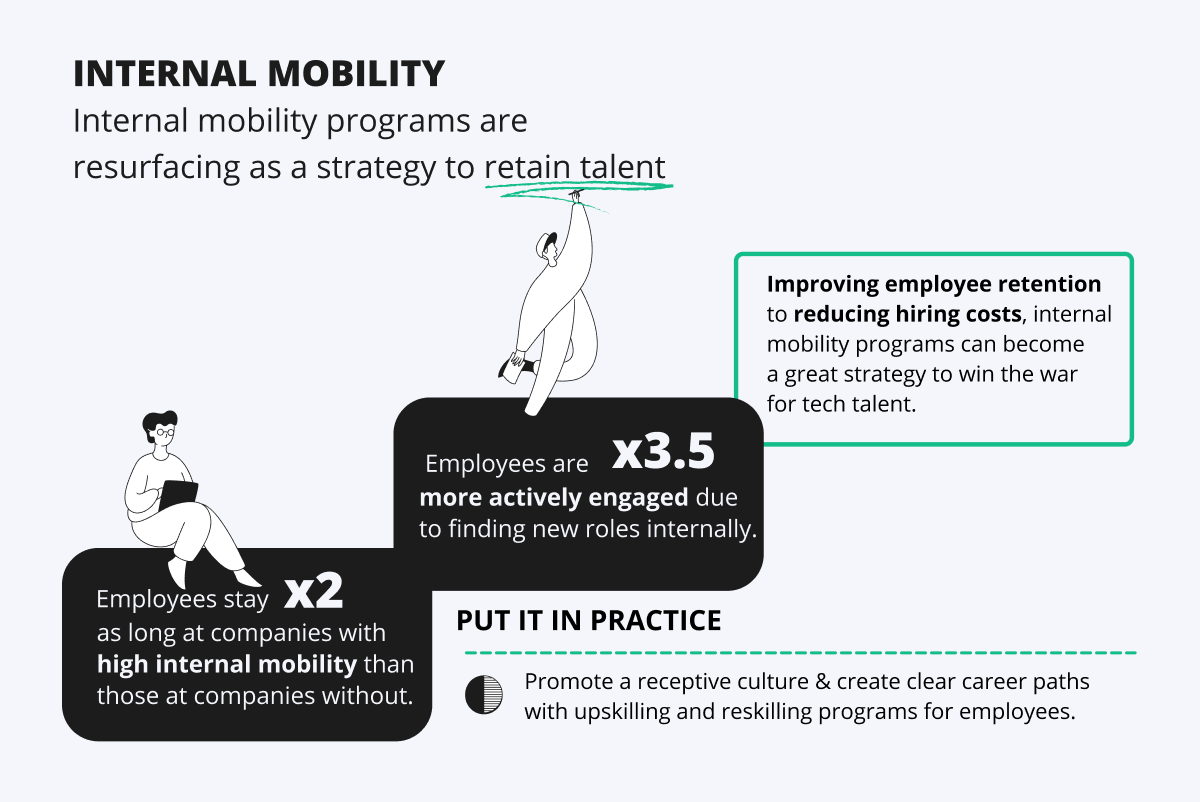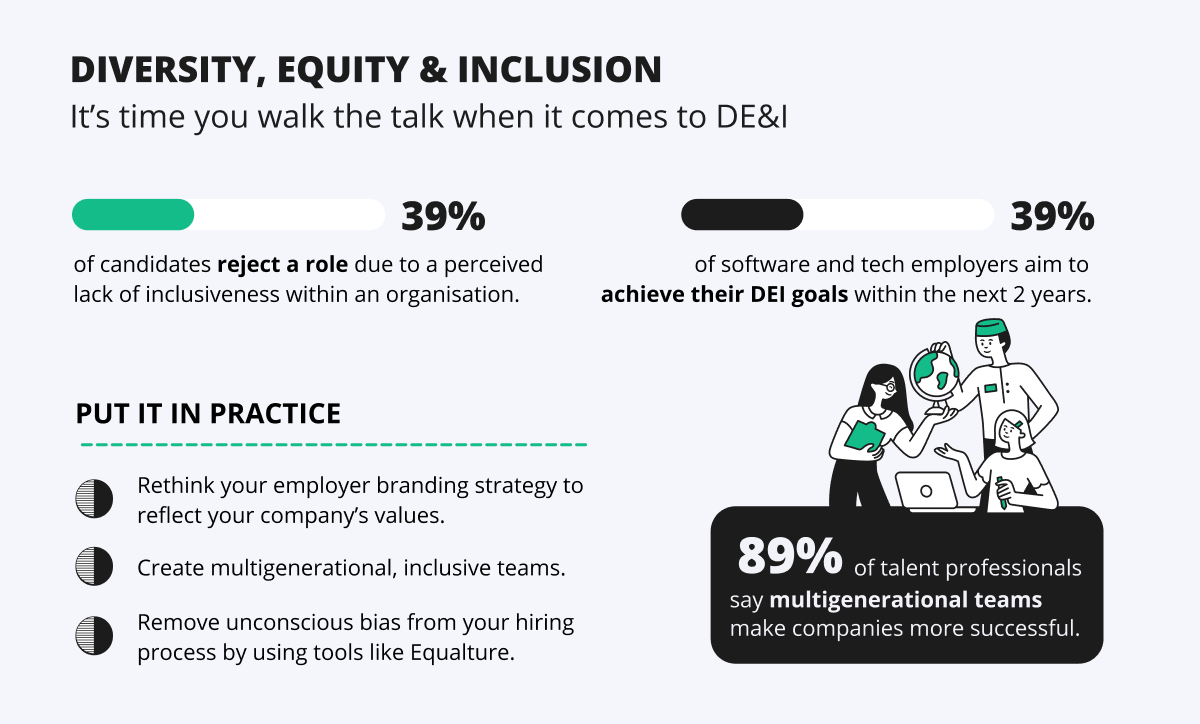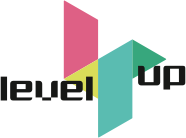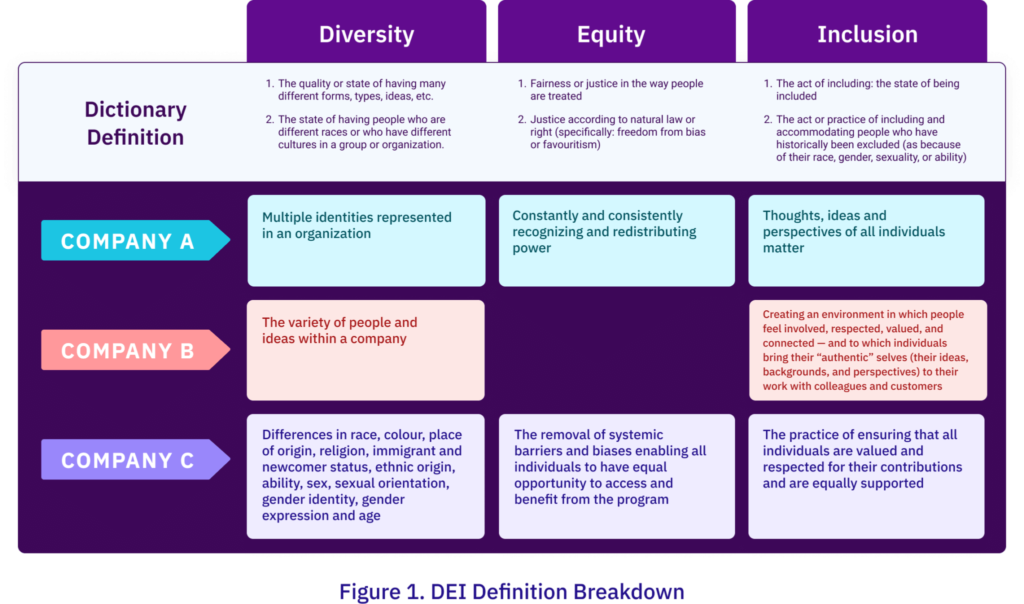This year, startups and scale-ups are thinking differently about their talent strategy. From workplace values to the latest technology, startups and scale-ups are finding new ways to leverage their assets and fulfil their hiring needs.
As predicted last year, the war for talent is here. With a tight labour market, people prioritizing their work-life balance, and rethinking how, why and where they work, startups and scale-ups are looking at a major competition for retaining, attracting and hiring talent.
As you set out to hit your first hiring milestone of the year, here are a few trends that you can adopt for a successful hiring strategy in 2022.
2022 Recruitment Trends
Trend #1: Internal mobility programs are resurfacing as a strategy to retain talent
Building successful teams goes beyond finding the right talent. It’s also about retaining the talent you have. The Great Resignation wave from 2021 is developing into the Great Reshuffle in 2022, where employees are reevaluating their careers and are holding employers to higher standards. Talent is moving away from the “hustle” culture, focusing on a more harmonious work-life balance, looking for opportunities to improve their skills and seeking greater flexibility in their careers.
With 74% of professionals believing employee turnover will increase in 2022, the pressure to keep talent is high. The challenge is even greater for startups looking for highly-skilled employees, but have lower budgets and resources to find and attract this talent. Internal mobility programs increase the attractiveness of a company while saving time and resources, turning into a great strategy to win the war for talent.
Talent retention is moving front and centre in 2022 and one way to retain your employees is to invest in them by providing opportunities for professional growth. Employees stay almost twice as long at companies with high internal mobility than those at companies without. Additionally, employees who have found new roles internally are three and a half times more likely to be actively engaged than those who haven’t.

Promote a receptive culture for internal mobility and get your employees involved
Founders and C-suites should model a receptive culture in which people are encouraged to look internally for new opportunities and challenges. The key to this is two-way communication. From talking openly with your teams to encouraging employees to share their thoughts, ideas and plans for their own development, you can create an open environment, where the employee is in the driver seat.
For example, Udemy, an online learning and teaching platform, has created multiple internal mobility programs that encourage employees to develop their careers. Such program is MentorU, which connects employees with more experienced individuals within Udemy for mentorship and career growth, allowing them to realize their full potential within the company.
Create clear career paths with upskilling & reskilling programs for employees
There are several ways startups and scale-ups can promote internal mobility for employees to upskill and advance in their careers. One option is to make a skills profile for your employees and keep track of their development. At LevelUp, we use people management tools like Lattice, which allows managers to gather data from their 1:1s, create individual development goals and assess their progress. Similar features can be found in other tools like OfficeVibe and Leapsome.
From there, you can create lateral mobility paths, where an employee takes on a whole new role in the company (e.g. a junior content marketer who wants to dive into UX/UI can become a junior UX designer), or vertical mobility paths, where the employee moves higher in position (e.g. from junior to associate), with additional responsibilities.
Uber is a great example. They’ve invested in a multi-faceted internal mobility program where 20% of their recruiting efforts are solely internal. Since the rollout of their program 30-40% of their hires were internal, and those who moved into a new role stayed with the company twice as long.
Trend #2: Hybrid-remote workplaces are here to stay, but should become an equal playing field for both remote and in-office employees
It’s no secret that the workplace is changing. Many startups and scale-ups have had to adjust to operating in a climate in and out of lockdown, and so have their teams. In fact, having the flexibility to choose where they can work has a major impact on the talent’s decision to choose a job, as 49% of professionals say they would turn down a job offer if the company asked them to go into the office full-time. Also, having the possibility to work remotely can increase employee retention, as people who are satisfied with their flexibility on work schedule or location are almost three times more likely to be happy working for their employer and two times more likely to recommend working for the company.
What we discovered last year is that there’s no one-size-fits-all formula for a remote workplace. Most successful companies find the right formula by testing multiple approaches. With over 10 models of remote and hybrid teams identified by Gitlab, the hybrid-remote model stands out this year. This approach allows employees to choose for themselves where they want to work, having the possibility to work either remotely or physically in an office. The hybrid-remote approach is usually combined with the virtual-first or remote-first approach, which serves first the distributed workforce, by adjusting the workflows and meetings to remote.
However, no remote working formula is without its disadvantages. One of the main challenges of the hybrid-remote approach is finding the right balance between remote and in-person employees. With in-office employees having face-to-face interactions, sharing information and experiences, remote employees might miss pieces of information, feel left out and disconnected from the rest of the team.

Understand when you need people in-office or remotely
One way startups and scaleups can adapt to this trend is by knowing when you need people in-office and when you can collaborate remotely. For example, Slack announced in June 2021 that they will transition to a ‘remote-first workforce’. This means that in-person meetings will only be used for team-building exercises and project kickoffs.
Another good example is Hubspot, which starting January 2021, they are giving their employees three options to choose from based on how they do their best work: in-office, where employees come to the offices three or more times a week, flex, where employees can go to the office two or fewer days a week with support for a work-from-home setup and home, where employees work fully remote, with the full support for work-from-home setup. Also, they are adjusting their workflows, with remote-first onboarding and location-agnostic benefits & perks
Make use of tools and technologies that support collaboration
Communication plays an important role in adopting the hybrid approach and should be used as a way to ensure that no one is ever left out of the loop because of their work location. For example, at LevelUp we use Notion as our main company “Wikipedia”. On our Notion page, we usually include information about the company, our processes, as well as recordings of our company-wide meetings.
With in-office employees having access to multiple office facilities like ergonomic furniture and tech that makes collaboration easier, it’s only fair remote employees would benefit from the same, in order to create an equal playing field. For this, you can make use of remote office procurement platforms, like Workwize, which supports companies in facilitating fully-fledged home offices by providing and maintaining any kind of remote equipment.
Trend #3: It’s time you walk the talk when it comes to DEI
Diversity, equity and inclusion (DEI) is not a new topic in your hiring strategy, but now it’s time for that topic to become a priority. With remote working allowing for the talent pool to become increasingly diverse, people are looking for companies where the culture aligns with their values. In fact, not making DEI one of the priorities in your hiring process can affect your ability to hire talent, as 39% of candidates reject a role due to a perceived lack of inclusiveness within an organisation. Fortunately, the landscape is already changing. Thirty-nine per cent of software and tech employers are aiming to achieve their DEI goals within the next 2 years.
Rethink your employer branding strategy to reflect your company’s values
Think of your employer brand as a one-way mirror you’d find in an interrogation room. A window into your company from a potential employee’s perspective and a mirror looking back at you. What do you see in the reflection? And what would a candidate see?
One starting point for revamping your employer branding is the messaging on your career site. Focus on inclusive, authentic content that reflects your company’s values. The more information candidates have about your company and its mission, culture and purpose, the more likely they are to apply for the job. Also, you can improve your job application rate by experimenting with inclusive landing pages targeting diverse candidate segments.
However, weaving DEI and employer branding shouldn’t only be about the career page. From the way you write your job descriptions to your social media posts and even internally, DEI should be reflected in your entire employer branding strategy.
Hire and create multigenerational teams
With Gen Z entering the workforce, age diversity is becoming much more commonplace. Eighty-nine per cent of talent professionals say multigenerational teams make companies more successful. So why not leverage the experiences of multiple generations? By creating multigenerational teams, employees are able to learn new skills from their peers and combine them with their own generational experiences for a stronger impact on company success.
By creating learning opportunities, discouraging generational bias and stereotypes, and collecting internal feedback, startups and scaleups can overcome multigenerational workforce challenges and instead reap the benefits of it.
For example, the marketing platform Later created a strong multi-generational team by encouraging two-way mentorships. By implementing lunch-and-learns where three random team members share a passion or area of expertise with the rest of the team, the company promotes an open environment for learning, no matter the age of its employees.
Remove unconscious bias from your hiring process
With more and more recruiting tools rising in order to combat unconscious bias, there is no longer an excuse for your recruiting team to not have hiring practices that are both fair and inclusive. For example, LinkedIn has released a new feature where recruiters can source without looking at a candidate’s profile photo or name. Instead, a blank profile photo will be displayed, along with the candidates’ initials. Another tool for removing unconscious bias is Equalture, which allows recruiting teams to measure candidates’ skills and behaviours without bias through gamified assessments.

Trend #4: Automation and recruitment tools are used to efficiently nurture candidates and create a more personalised experience
The key to attracting and hiring top talent is a top-rate candidate experience. Ideally, every moment of their application process – from the initial contact to the offer letter – should feel personal, and already nurture a relationship that will continue to thrive well into their tenure.
The quest to nurture every candidate, however, is a difficult one. With increased competition and less time, recruiting teams can’t manually respond to every candidate. The candidates slip away, the competition intensifies and the cycle continues.
Automation is an easy solution for nurturing candidates. Sixty-eight per cent of recruiting pros recommend improved recruiting tools as the top performance booster over the next five years.

Startups and scale-ups have many options for automating their recruitment and hiring process, from implementing application tracking systems (ATS) to utilising artificial intelligence (AI), augmented reality and natural language processing tools (NLP). The possibilities are endless, but here are a few to consider:
- NLP tools like chatbots are a great addition to the recruitment process. The chatbot technology uses personalised communication to interact directly with the candidates.
- Candidate relationship management (CRM) systems are excellent for reducing cost per hire by up to 39%. Beamery, Jibe, Smashfly, TalentBrew, Yello, and Avature are all commonly used by recruiters to engage candidates throughout the entire hiring process.
- Automated email flows are great for nurturing your candidates and keeping them engaged throughout the process. You also have the option to send automated reminders to update candidates on the next steps, like upcoming interviews and assessments.
Gain competitive advantage to win the war for talent in 2022
By staying ahead of these trends, startups and scale-ups are likely to gain competitive advantage when it comes to winning the war for talent. However, with employee turnover estimated to increase in 2022 and workers holding their employers to higher standards, your efforts should start internally in order to retain the people you have today. Begin investing in the talent you have by tracking their individual development goals and encouraging employees to seek new opportunities and challenges within the company.
Creating a balanced work environment by providing your employees with the flexibility of where they want to work is a great way to strengthen your employer branding internally and increase employee satisfaction. Reflecting your values through your employer branding strategy, putting intentional DEI policies and programs in practice and removing unconscious bias from your recruitment process will attract diverse talent and add to overall company success. And utilising tools like chatbot technologies and automated email flows to nurture candidates, personalise the experience and optimise the hiring process is a smart move for any lean startup or scale-up.
Building your team is no small task, and we’re here to support you every step of the way. Let’s start the year with new recruitment practices in place to hit your hiring goals for 2022.


